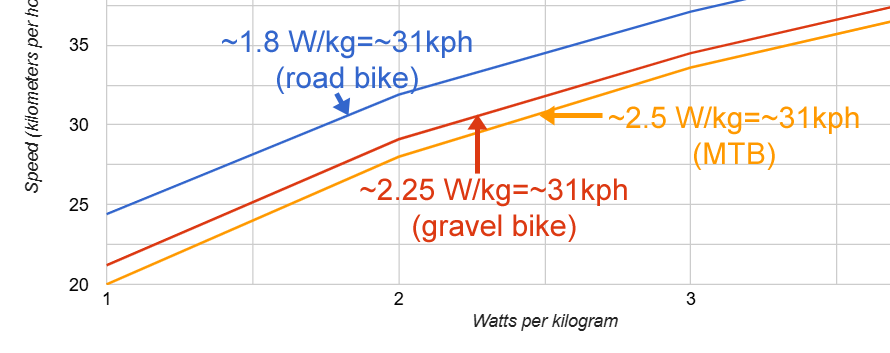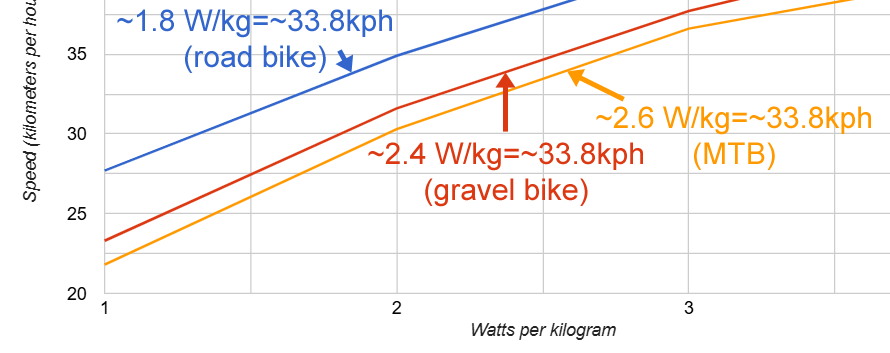Important: this post contains performance data which was invalidated in Zwift’s mid-March 2025 update. Learn about those changes and get updated performance data >
I recently agreed to lead a group ride on Zwift. This was a charity ride, and just one event in a series meant to deliver a consistent, inclusive experience for everyone.
The ride’s stated pace was 1.8 W/kg, which works out to 151 watts for me since I weigh 84kg. But I wasn’t thrilled with the prospect of spending 90 minutes on Tempus Fugit at 150 watts, since that effort just felt too low. My easy zone 2 rides are typically closer to 200 watts.
(Side note: Tadej Pogacar recently revealed that his zone 2 efforts on flat roads are in the 290-300W range. And he only weighs 66kg, putting his zone 2 at 4.4-4.5 W/kg. That’s just crazy.)
Anyway, given that I didn’t want to just spin my legs for 90 minutes, I began pondering ways I could put in the effort I was targeting on the day, while still delivering the intended ride experience for everyone else. Or to put it more succinctly: how could I make my effort a bit harder, without actually speeding up the ride and making everyone else work harder to keep up?
Yes, I could change my height in game (read how height affects speed in Zwift) or change my weight (read how weight affects speed in Zwift), or do a combination of the two. That would have gotten me where I wanted to be. But the more I thought about it, the more I liked the idea of doing in game what I might do outside in a similar situation. What if I changed to a slower bike in Zwift, forcing me to work a bit harder to hit the speed I would have hit at 1.8 W/kg on a road bike?
I did this outside just a few weeks ago, actually. A friend of mine wanted to go on a road ride, but he hasn’t been riding long. So I met him on my mountain bike, and we rode around for an hour: him on a road bike, me on a mountain bike, both getting the workout we wanted while hanging out together.
As I looked into doing this on Zwift, though, I had a question: just how much would switching to a gravel or MTB slow me in game? That is, what sort of bike did I need to choose if I wanted to match the speed I would have traveled at 1.8 W/kg on a road bike while holding closer to my target of 2.4 W/kg?
I put the bots to work. And I ran the tests at various power levels, so the results could be used by ride leaders and participants taking part in rides with various stated paces. Let’s dive into the results!
Lone Rider (No Drafting)

I began by testing a lone rider on the Tempus Fugit course. This is the flattest route in Zwift, and it’s where I would be leading my group ride. The rider was my standard bot: 183cm tall, 75kg in weight. I tested at 1, 2, 3, and 4 W/kg (so 75, 150, 225, and 300 Watts, respectively). And I tested using a representative road bike (Specialized Venge S-Works with DT Swiss Disc), gravel bike (Specialized Crux with Roval gravel wheels), and MTB (Scott Spark RC World Cup).
Here are the results of the lone rider tests:
Nothing surprising here… the road bike is faster than the gravel bike, which is faster than the MTB. (Any self-respecting Zwifter already understands this, as bike performance in Zwift is a product of Crr as well as frame and wheel aero and weight parameters. Like outdoors, albeit a bit simplified.)
What’s more interesting, for the purposes of this discussion, is to look at where the lines meet particular speeds or W/kg. If I look at where the road bike’s line hits approximately 1.8 W/kg, I can see that equates to approximately 31 kilometers per hour. Move horizontally from there to meet the gravel bike’s line and I see that to hold 31kph on the gravel bike I would need to hold ~2.25 W/kg. Move a bit more to the right to the MTB line, and I can see it will take 2.5 W/kg to hold 31kph on the MTB.

This chart can be used for other paces, too. Is the ride supposed to be led at 3 W/kg? That would be around 34.5 kph, which would require ~3.6 W/kg on the gravel bike and ~3.8 W/kg on the MTB.
But wait… we’re not done yet. This test only shows what happens with a single rider, but you’re leading a group ride that (hopefully) has lots of participants! In that situation, what usually happens (especially on lower-paced group rides) is the leader sits in the middle of the group, holding the stated pace, while the group bunches around the leader.
That means you’ll probably be sitting in the draft, holding the target pace. And that changes things. It means you’ll be traveling faster at the target W/kg than you would be yourself.
Time for a second set of tests.
Drafting Rider

For these tests, I used two bots. The drafting bot was simulating me, the ride leader, holding the target W/kg. And the bot ahead, in the wind, was the ride participant, giving the ride leader a helpful draft. I pushed the lead bot’s power as high as it could go without dropping the drafting bot. This ensured our “pack” was moving as fast as possible.
In this scenario, the lines look similar to the first test – they’re mostly just shifted higher, as I’m able to hold a higher speed for a given power output when I’m drafting. (Again, basic cycling physics). If we go again to the 1.8 W/kg mark on the road bike, we can move horizontally to find target power numbers if I choose to ride a gravel or MTB:

And so we arrive at the answer to the question that started this whole experiment. If I’m asked to lead a flat road ride at 1.8 W/kg, what W/kg would I need to hold in order to keep the ride at the stated pace while riding a gravel bike or MTB?
The answer, with some necessary approximation built in, is ~2.4 W/kg on the gravel bike, or ~2.6 W/kg on the MTB. And that works out perfectly for me, since 2.4 W/kg is 202W at my weight.
Nerd note #1: for extra credit, I can look and see that if I happen to poke my nose into the wind, I would need to increase my power to ~2.9 W/kg in order to maintain the pack speed of 33.8kph that is expected at this pace.
Nerd note #2: if you’re wondering why the power numbers for gravel and MTB to match the road bike are higher in the drafting test than the lone rider test, it’s because as speed increases, more power is required to overcome a given rolling resistance. Since both the gravel and MTB have a higher rolling resistance than the road bike on tarmac, they’ll require relatively more power as speeds increase.
Wrapping It Up: Leading Well
So I found my target power number(s) for the ride, and worked to hold them consistently to ensure a good ride experience for everyone.
And since I try to be a good ride leader who leads clearly, I even messaged the group to let them know that I was on a gravel bike, so my W/kg would be higher than expected, but the overall ride speed would not be.
When all was said and done, by riding the gravel bike I got the workout I was looking for, and everyone else got to ride at the stated pace of the ride they joined. A win-win!
Questions or Comments?
Have you ever used this trick in a Zwift group ride? How about outdoors? Share your thoughts below…